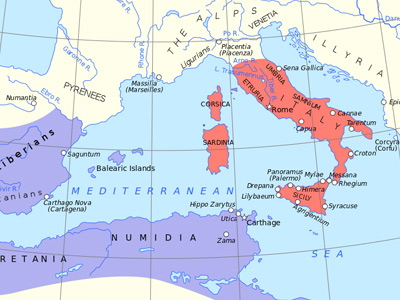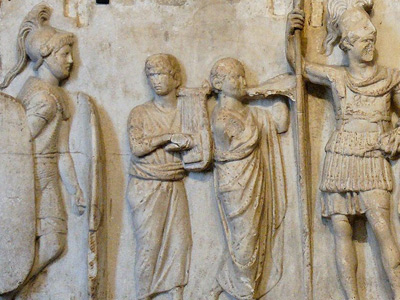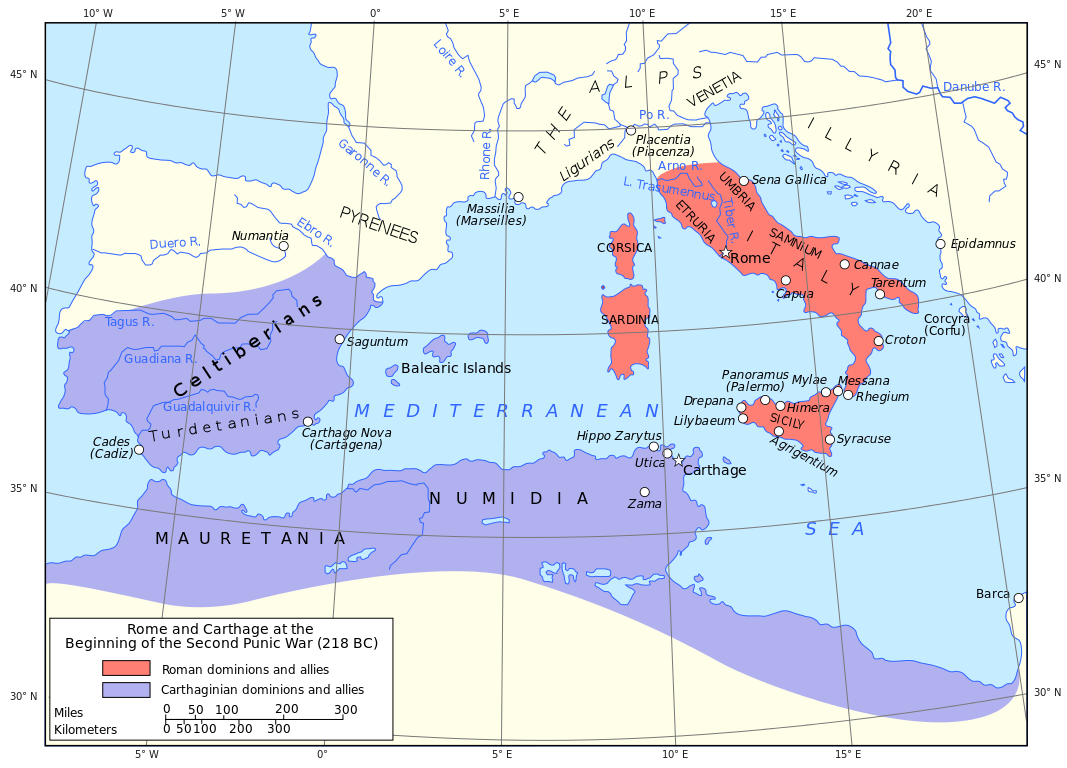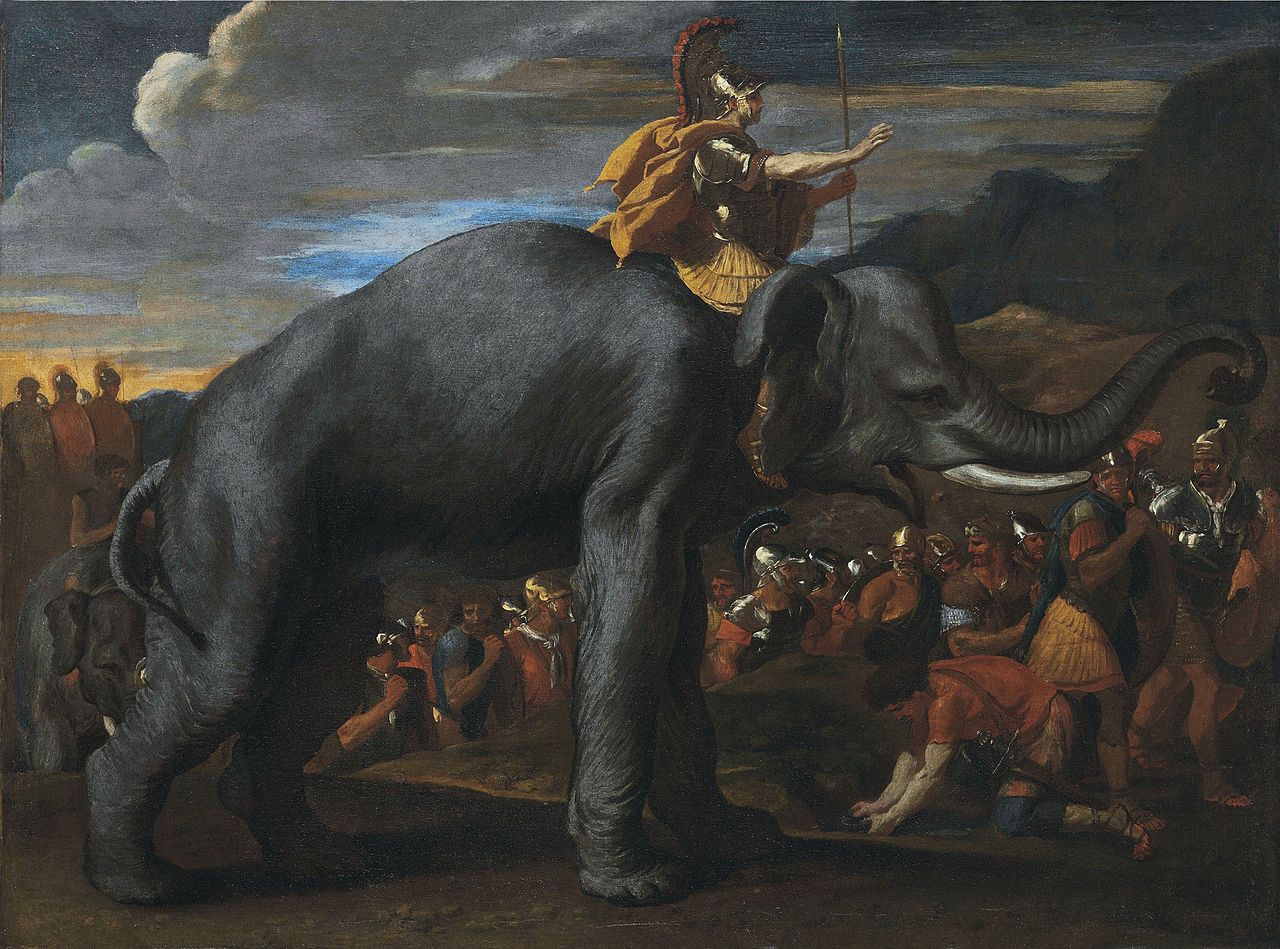Second Punic War (218-201 BC)
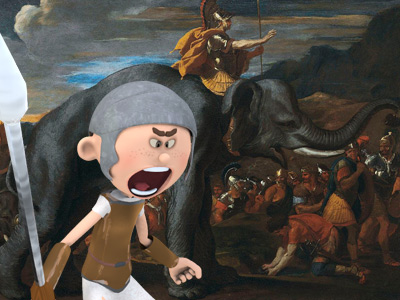
Carrying the War to Africa
In 205, Mago landed in Genua by sea the remnants of his Spanish army. This was the third Carthaginian force invading Italy. It soon received Gallic and Ligurian reinforcements. Mago's arrival in the north of the Italian peninsula was followed by Hannibal's Battle of Crotona in 204 in the south of the peninsula. Mago marched his reinforced army towards the lands of the Boii and Insubres, Carthage's main Gallic allies and a place of retreat for Hasdrubal's defeated remnants. His move was checked by the Romans The Roman Republic was a form of government of Rome and the era of the classical Roman civilization when it was run through public representation of the Roman people. Beginning with the overthrow of the Roman Kingdom (traditionally dated to 509 BC) and ending in 27 BC with the establishment of the Roman Empire, Rome's control rapidly expanded during this period - from the city's immediate surroundings to hegemony over the entire Mediterranean world. in the Po Valley Raid in 203. This hindered the third attempted invasion of Italy early, from uniting with Hannibal's
The Roman Republic was a form of government of Rome and the era of the classical Roman civilization when it was run through public representation of the Roman people. Beginning with the overthrow of the Roman Kingdom (traditionally dated to 509 BC) and ending in 27 BC with the establishment of the Roman Empire, Rome's control rapidly expanded during this period - from the city's immediate surroundings to hegemony over the entire Mediterranean world. in the Po Valley Raid in 203. This hindered the third attempted invasion of Italy early, from uniting with Hannibal's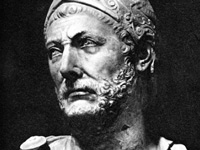 Hannibal Barca (247-183 BC), was a Carthaginian general, considered one of the greatest military commanders in history. Hannibal lived during a period of great tension in the western Mediterranean Basin, when the Roman Republic established its supremacy over other great powers such as ancient Carthage. One of his most famous achievements was at the outbreak of the Second Punic War, when he marched an army which included war elephants from Iberia over the Pyrenees and the Alps into Italy. Hannibal Barca » army in the south. The split Carthaginian armies were less dangerous, allowing for Roman manpower to be directed to the invasion of Africa, despite the Damocles sword of the enemy troops on and around Roman lands.
Hannibal Barca (247-183 BC), was a Carthaginian general, considered one of the greatest military commanders in history. Hannibal lived during a period of great tension in the western Mediterranean Basin, when the Roman Republic established its supremacy over other great powers such as ancient Carthage. One of his most famous achievements was at the outbreak of the Second Punic War, when he marched an army which included war elephants from Iberia over the Pyrenees and the Alps into Italy. Hannibal Barca » army in the south. The split Carthaginian armies were less dangerous, allowing for Roman manpower to be directed to the invasion of Africa, despite the Damocles sword of the enemy troops on and around Roman lands.

Publius Cornelius Scipio's military campaign in Africa (204–203 B.C.)

Publius Cornelius Scipio's military campaign in Africa (204–203 B.C.)
( Click image to enlarge)
At the same time, Scipio Africanus Major was given command of the legions in Sicily and was allowed to levy volunteers for his plan to end the war by an invasion of Africa. The legions in Sicily were mainly the survivors of Cannae, who were not allowed home until the war was finished. Scipio was also one of the survivors but, unlike the ordinary soldiers, had been allowed to return to Rome along with the other surviving tribunes, and had run successfully for public office and had been given command of the troops in Iberia.
Within a year of his landing in Africa, Scipio twice routed the regular Carthaginian forces, under Hasdrubal Gisco, and his Numidian allies. The main native supporter of the Carthaginians, king Syphax of the Massaesylians (western Numidians), was defeated and taken prisoner. Masinissa, a Numidian rival of Syphax and, at that time, an ally of the Romans, seized a large part of his kingdom with their help. These setbacks persuaded some of the Carthaginians that it was time to sue for peace. Others pleaded for the recall of the sons of Hamilcar Barca, Hannibal and Mago, who were still fighting the Romans in Bruttium and Cisalpine Gaul respectively.
In 203 BC, while Scipio was carrying all before him in Africa and the Carthaginian peace party were arranging an armistice, Hannibal was recalled from Italy by the war party at Carthage. After leaving a record of his expedition engraved in Punic and Greek upon bronze tablets in the temple of Juno at Crotone, he sailed back to Africa. These records were later quoted by Polybius. Hannibal's arrival immediately restored the predominance of the war party, who placed him in command of a combined force of African levies and his mercenaries from Italy. But Hannibal was opposed to this policy and tried to convince them not to send the untrained African levies into battle. In 202 BC, Hannibal met Scipio in a peace conference. Despite the two generals' mutual admiration, negotiations foundered, according to the Romans due to "Punic faith", meaning bad faith. This Roman expression referred to the alleged breach of protocols which ended the First Punic War by the Carthaginian attack on Saguntum, Hannibal's perceived breaches of what the Romans perceived as military etiquette (i.e. Hannibal's numerous ambuscades), as well as the armistice violated by the Carthaginians in the period before Hannibal's return.
Related Articles
First Punic War (264-241 BC)
The first of three wars fought between Ancient Carthage and the Roman Republic. For more than 20 years, the two powers struggled for supremacy, primarily on the Mediterranean island of Sicily and its surrounding waters, and also in North Africa. View First Punic War (264-241 BC) »
Second Punic War (218-201 BC)
The Second Punic War, also referred to as The Hannibalic War and (by the Romans) the War Against Hannibal, lasted from 218 to 201 BC and involved combatants in the western and eastern Mediterranean. View Second Punic War (218-201 BC) »
Third Punic War (149–146 BC)
Was the third and last of the Punic Wars fought between the former Phoenician colony of Carthage and the Roman Republic. This war was a much smaller engagement than the two previous Punic Wars and focused on Tunisia. View Third Punic War (149–146 BC) »
HISTORY
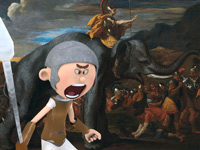
RESOURCES
This article uses material from the Wikipedia article "Second Punic War", which is released under the Creative Commons Attribution-Share-Alike License 3.0.
© Stories Preschool. All Rights Reserved.
